fuel type FIAT 500L 2018 Owner handbook (in English)
[x] Cancel search | Manufacturer: FIAT, Model Year: 2018, Model line: 500L, Model: FIAT 500L 2018Pages: 268, PDF Size: 4.87 MB
Page 41 of 268
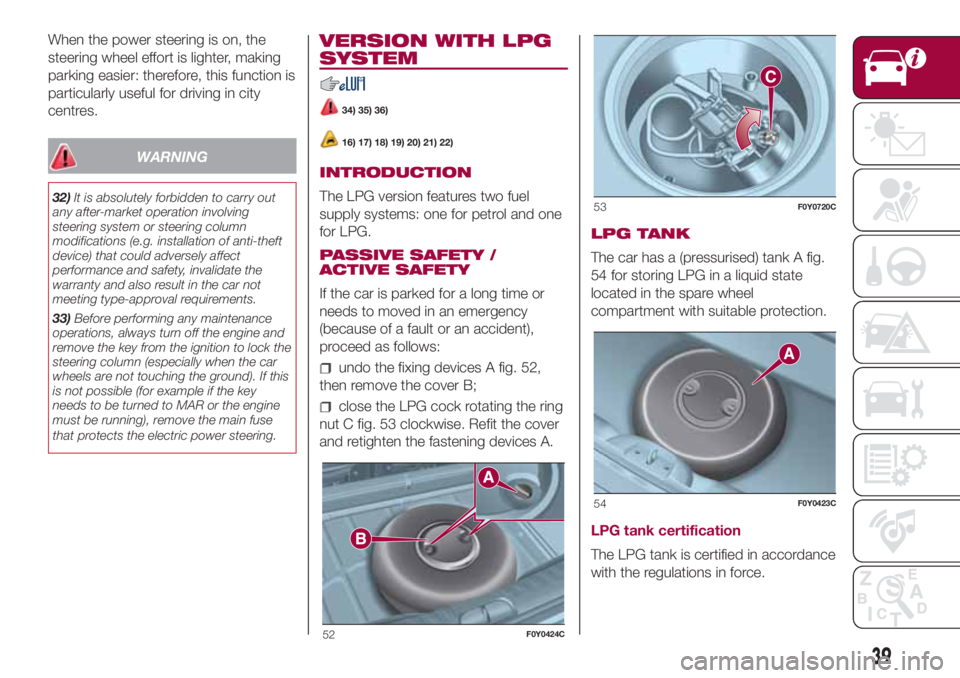
When the power steering is on, the
steering wheel effort is lighter, making
parking easier: therefore, this function is
particularly useful for driving in city
centres.
WARNING
32)It is absolutely forbidden to carry out
any after-market operation involving
steering system or steering column
modifications (e.g. installation of anti-theft
device) that could adversely affect
performance and safety, invalidate the
warranty and also result in the car not
meeting type-approval requirements.
33)Before performing any maintenance
operations, always turn off the engine and
remove the key from the ignition to lock the
steering column (especially when the car
wheels are not touching the ground). If this
is not possible (for example if the key
needs to be turned to MAR or the engine
must be running), remove the main fuse
that protects the electric power steering.
VERSION WITH LPG
SYSTEM
34) 35) 36)
16) 17) 18) 19) 20) 21) 22)
INTRODUCTION
The LPG version features two fuel
supply systems: one for petrol and one
for LPG.
PASSIVE SAFETY /
ACTIVE SAFETY
If the car is parked for a long time or
needs to moved in an emergency
(because of a fault or an accident),
proceed as follows:
undo the fixing devices A fig. 52,
then remove the cover B;
close the LPG cock rotating the ring
nut C fig. 53 clockwise. Refit the cover
and retighten the fastening devices A.LPG TANK
The car has a (pressurised) tank A fig.
54 for storing LPG in a liquid state
located in the spare wheel
compartment with suitable protection.
LPG tank certification
The LPG tank is certified in accordance
with the regulations in force.
52F0Y0424C
53F0Y0720C
54F0Y0423C
39
Page 42 of 268
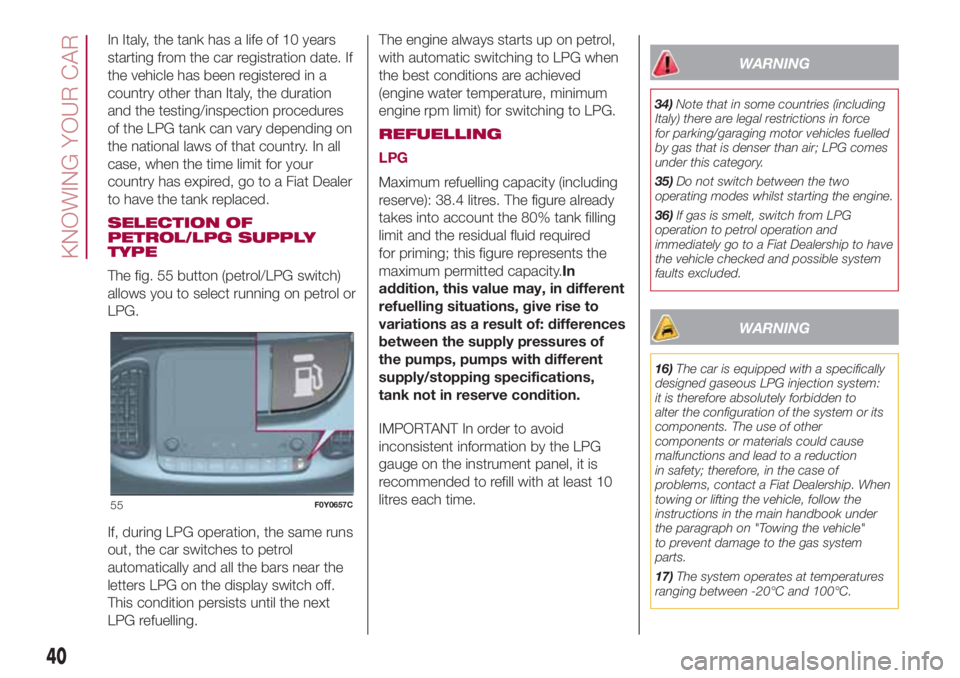
In Italy, the tank has a life of 10 years
starting from the car registration date. If
the vehicle has been registered in a
country other than Italy, the duration
and the testing/inspection procedures
of the LPG tank can vary depending on
the national laws of that country. In all
case, when the time limit for your
country has expired, go to a Fiat Dealer
to have the tank replaced.
SELECTION OF
PETROL/LPG SUPPLY
TYPE
The fig. 55 button (petrol/LPG switch)
allows you to select running on petrol or
LPG.
If, during LPG operation, the same runs
out, the car switches to petrol
automatically and all the bars near the
letters LPG on the display switch off.
This condition persists until the next
LPG refuelling.The engine always starts up on petrol,
with automatic switching to LPG when
the best conditions are achieved
(engine water temperature, minimum
engine rpm limit) for switching to LPG.
REFUELLING
LPG
Maximum refuelling capacity (including
reserve): 38.4 litres. The figure already
takes into account the 80% tank filling
limit and the residual fluid required
for priming; this figure represents the
maximum permitted capacity.In
addition, this value may, in different
refuelling situations, give rise to
variations as a result of: differences
between the supply pressures of
the pumps, pumps with different
supply/stopping specifications,
tank not in reserve condition.
IMPORTANT In order to avoid
inconsistent information by the LPG
gauge on the instrument panel, it is
recommended to refill with at least 10
litres each time.
WARNING
34)Note that in some countries (including
Italy) there are legal restrictions in force
for parking/garaging motor vehicles fuelled
by gas that is denser than air; LPG comes
under this category.
35)Do not switch between the two
operating modes whilst starting the engine.
36)If gas is smelt, switch from LPG
operation to petrol operation and
immediately go to a Fiat Dealership to have
the vehicle checked and possible system
faults excluded.
WARNING
16)The car is equipped with a specifically
designed gaseous LPG injection system:
it is therefore absolutely forbidden to
alter the configuration of the system or its
components. The use of other
components or materials could cause
malfunctions and lead to a reduction
in safety; therefore, in the case of
problems, contact a Fiat Dealership. When
towing or lifting the vehicle, follow the
instructions in the main handbook under
the paragraph on "Towing the vehicle"
to prevent damage to the gas system
parts.
17)The system operates at temperatures
ranging between -20°C and 100°C.
55F0Y0657C
40
KNOWING YOUR CAR
Page 44 of 268
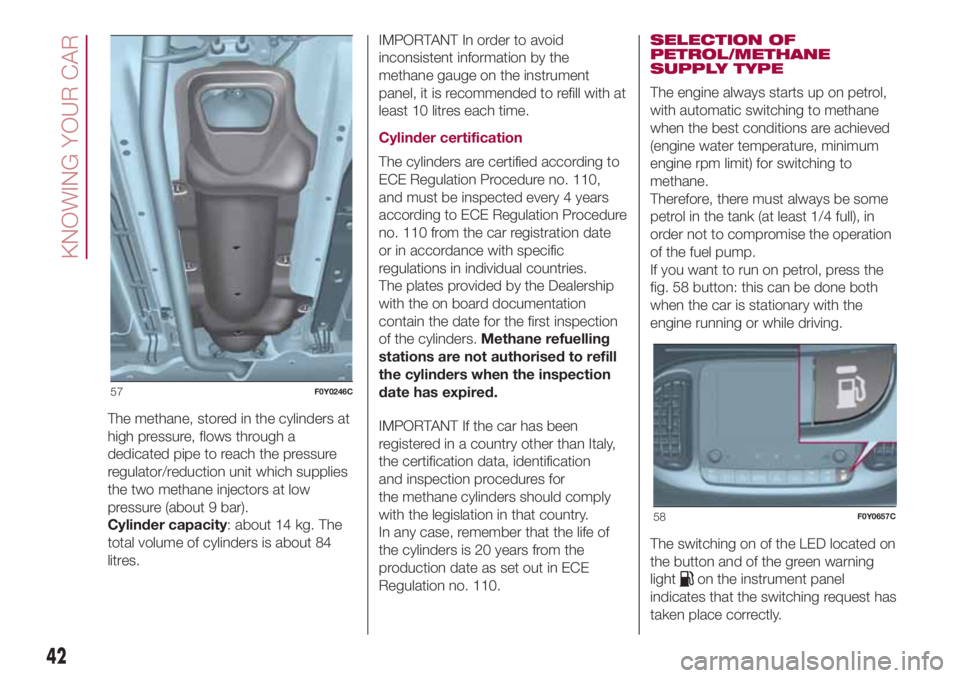
The methane, stored in the cylinders at
high pressure, flows through a
dedicated pipe to reach the pressure
regulator/reduction unit which supplies
the two methane injectors at low
pressure (about 9 bar).
Cylinder capacity: about 14 kg. The
total volume of cylinders is about 84
litres.IMPORTANT In order to avoid
inconsistent information by the
methane gauge on the instrument
panel, it is recommended to refill with at
least 10 litres each time.
Cylinder certification
The cylinders are certified according to
ECE Regulation Procedure no. 110,
and must be inspected every 4 years
according to ECE Regulation Procedure
no. 110 from the car registration date
or in accordance with specific
regulations in individual countries.
The plates provided by the Dealership
with the on board documentation
contain the date for the first inspection
of the cylinders.Methane refuelling
stations are not authorised to refill
the cylinders when the inspection
date has expired.
IMPORTANT If the car has been
registered in a country other than Italy,
the certification data, identification
and inspection procedures for
the methane cylinders should comply
with the legislation in that country.
In any case, remember that the life of
the cylinders is 20 years from the
production date as set out in ECE
Regulation no. 110.SELECTION OF
PETROL/METHANE
SUPPLY TYPE
The engine always starts up on petrol,
with automatic switching to methane
when the best conditions are achieved
(engine water temperature, minimum
engine rpm limit) for switching to
methane.
Therefore, there must always be some
petrol in the tank (at least 1/4 full), in
order not to compromise the operation
of the fuel pump.
If you want to run on petrol, press the
fig. 58 button: this can be done both
when the car is stationary with the
engine running or while driving.
The switching on of the LED located on
the button and of the green warning
light
on the instrument panel
indicates that the switching request has
taken place correctly.
57F0Y0246C
58F0Y0657C
42
KNOWING YOUR CAR
Page 47 of 268
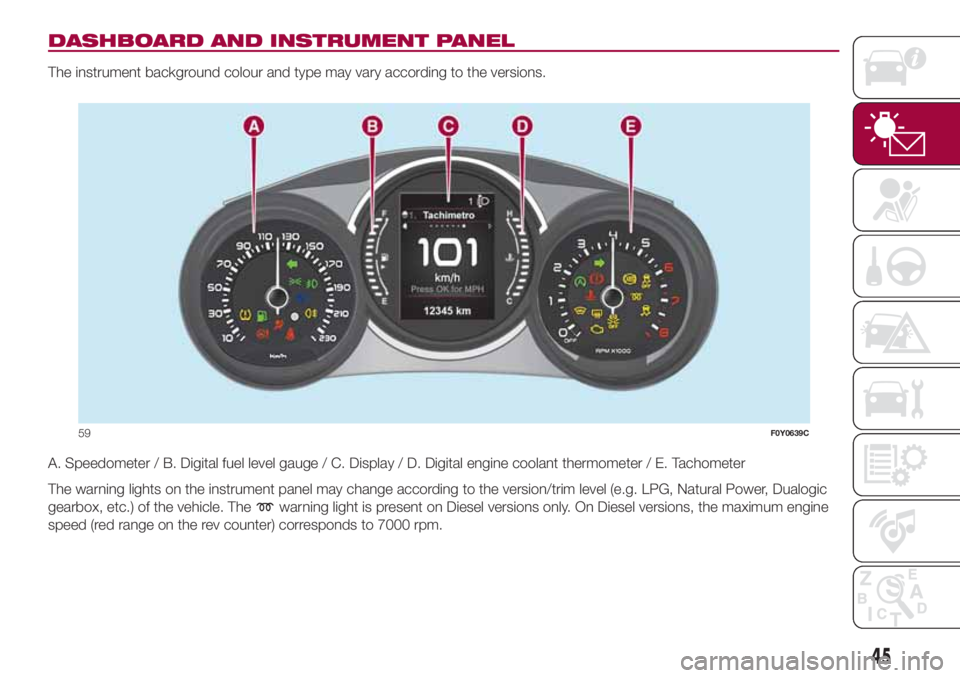
DASHBOARD AND INSTRUMENT PANEL
The instrument background colour and type may vary according to the versions.
A. Speedometer / B. Digital fuel level gauge / C. Display / D. Digital engine coolant thermometer / E. Tachometer
The warning lights on the instrument panel may change according to the version/trim level (e.g. LPG, Natural Power, Dualogic
gearbox, etc.) of the vehicle. The
warning light is present on Diesel versions only. On Diesel versions, the maximum engine
speed (red range on the rev counter) corresponds to 7000 rpm.
59F0Y0639C
45
Page 111 of 268

NOTE The engine can only be stopped
automatically after exceeding about
10 km/h, to prevent the engine from
being repeatedly stopped when driving
at walking pace.
The
warning light on the instrument
panel switches on to signal that the
engine has stopped.
Restarting the engine
Versions with manual transmission:
press the clutch pedal.
Versions with Dualogic
transmission: if the gear lever is in
position N (Neutral), place it in any other
gear, otherwise release the brake pedal
or move the gear lever to +, – or R.
MANUAL SYSTEM
ACTIVATION/
DEACTIVATION
To activate/deactivate the system
manually, press the
fig. 99 button.
LED off: system activated /LED on:
system deactivated.
WARNING
109)If the battery needs to be replaced,
always contact a Fiat Dealership. Replace
the battery with one of the same type
(HEAVY DUTY) and with the same
specifications.110)Before opening the bonnet, make
sure the engine is off and the ignition key is
in the STOP position. Always refer to the
plate inside the bonnet. We recommend
that you remove the key from the ignition if
other people remain in the vehicle. Exit
from the car only after having removed the
ignition key or having rotated it to the
STOP position. During refuelling, make sure
that the engine is off and that the ignition
key is in the STOP position.
WARNING
57)If the car is equipped with manual
climate control, if you want to favour
climate comfort, the Start&Stop system
can be deactivated for continuous climate
control system operation.
CRUISE CONTROL
(constant speed
regulator)
(for versions/markets, where provided)
111) 112) 113)
DESCRIPTION
This is an electronically controlled
driving assistance device that allows
the desired car speed to be maintained,
without having to press the accelerator
pedal. This device can be used at a
speed above 30 km/h on long stretches
of dry, straight roads with few
variations (e.g. motorways).
It is therefore not recommended to use
this device on extra-urban roads with
traffic. Do not use the device in town.
DEVICE ACTIVATION
Press button Afig. 100
. Activation of
the device is indicated by illumination
of the
symbol (coloured white)
on the display switching on (on some
versions a specific message is also
displayed).
Once the Speed Limiter is activated,
button A has to be pressed twice
to activate the Cruise Control.
99F0Y0653C
109
Page 120 of 268
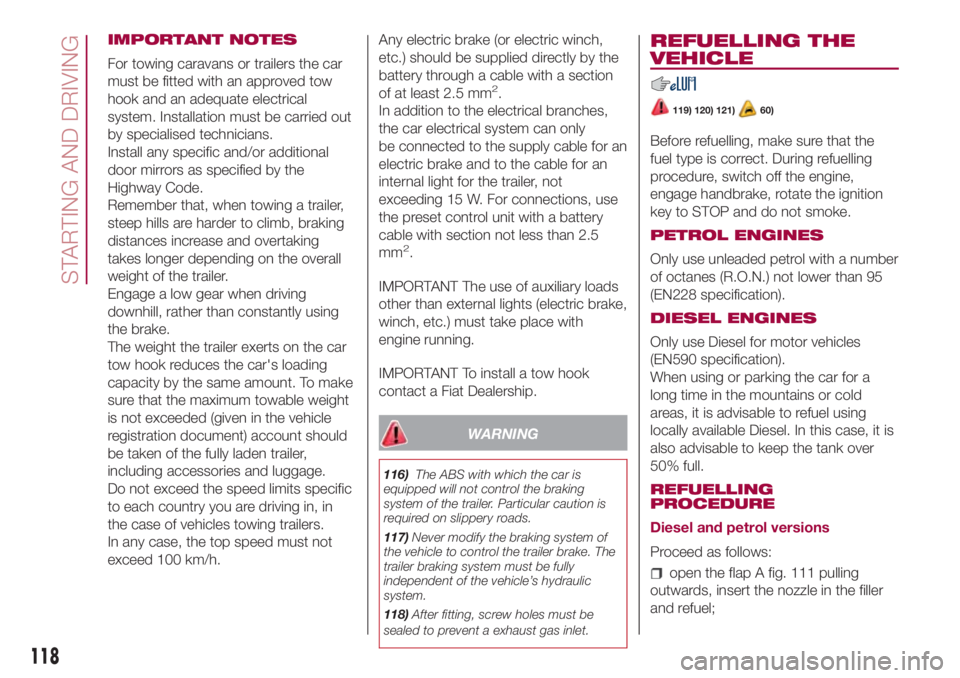
IMPORTANT NOTES
For towing caravans or trailers the car
must be fitted with an approved tow
hook and an adequate electrical
system. Installation must be carried out
by specialised technicians.
Install any specific and/or additional
door mirrors as specified by the
Highway Code.
Remember that, when towing a trailer,
steep hills are harder to climb, braking
distances increase and overtaking
takes longer depending on the overall
weight of the trailer.
Engage a low gear when driving
downhill, rather than constantly using
the brake.
The weight the trailer exerts on the car
tow hook reduces the car's loading
capacity by the same amount. To make
sure that the maximum towable weight
is not exceeded (given in the vehicle
registration document) account should
be taken of the fully laden trailer,
including accessories and luggage.
Do not exceed the speed limits specific
to each country you are driving in, in
the case of vehicles towing trailers.
In any case, the top speed must not
exceed 100 km/h.Any electric brake (or electric winch,
etc.) should be supplied directly by the
battery through a cable with a section
of at least 2.5 mm
2.
In addition to the electrical branches,
the car electrical system can only
be connected to the supply cable for an
electric brake and to the cable for an
internal light for the trailer, not
exceeding 15 W. For connections, use
the preset control unit with a battery
cable with section not less than 2.5
mm
2.
IMPORTANT The use of auxiliary loads
other than external lights (electric brake,
winch, etc.) must take place with
engine running.
IMPORTANT To install a tow hook
contact a Fiat Dealership.
WARNING
116)The ABS with which the car is
equipped will not control the braking
system of the trailer. Particular caution is
required on slippery roads.
117)Never modify the braking system of
the vehicle to control the trailer brake. The
trailer braking system must be fully
independent of the vehicle’s hydraulic
system.
118)After fitting, screw holes must be
sealed to prevent a exhaust gas inlet.
REFUELLING THE
VEHICLE
119) 120) 121)60)
Before refuelling, make sure that the
fuel type is correct. During refuelling
procedure, switch off the engine,
engage handbrake, rotate the ignition
key to STOP and do not smoke.
PETROL ENGINES
Only use unleaded petrol with a number
of octanes (R.O.N.) not lower than 95
(EN228 specification).
DIESEL ENGINES
Only use Diesel for motor vehicles
(EN590 specification).
When using or parking the car for a
long time in the mountains or cold
areas, it is advisable to refuel using
locally available Diesel. In this case, it is
also advisable to keep the tank over
50% full.
REFUELLING
PROCEDURE
Diesel and petrol versions
Proceed as follows:
open the flap A fig. 111 pulling
outwards, insert the nozzle in the filler
and refuel;
118
STARTING AND DRIVING
Page 121 of 268

after refuelling, before removing the
dispenser, wait for at least 10 seconds
in order for the fuel to flow inside the
tank;
then remove the dispenser from the
filler and close flap A.
The refuelling procedure described
above is illustrated on the label B fig.
111 located inside the fuel flap. The
label also indicates the fuel type
(UNLEADED FUEL=petrol,
DIESEL=diesel fuel).Flap A is provided with a dust cover
gaiter C fig. 111which prevents
deposits of impurities and dust at the
end of the filler when the flap is closed.
Emergency refuelling
If there is no fuel in the car or the supply
circuit is completely empty, proceed
as follows to reintroduce fuel to the
tank:
open the boot and get the adapter,
located in the toolbox or, depending
on the versions, in the Fix&Go
Automatic container;
open the fuel flap by pulling
outwards, insert the adapted in the filler,
as shown in fig. 112 and refuel;
after refuelling, remove the adapter
and close the flap;
reintroduce the adapter in the box
and put this back in the boot.LPG versions
To refuel, open the fuel flap A fig. 113
and undo the cap B. During the
refuelling operation, give the specific
refuelling adapter C fig. 113 to the LPG
fuel station personnel.
IMPORTANT Depending on the country,
there are various types of adapters for
LPG refuelling pumps. Filler adapter,
supplied with the vehicle and located in
a special case, is specifically designed
for the country in which the vehicle is
sold. If you are in a different country,
find out what type of adaptor is used
there.
IMPORTANT Only use LPG for motor
vehicles.
111F0Y0229C112F0Y0231C
113F0Y0327C
119
Page 122 of 268

Natural Power versions
61)
To refuel, open the flap A fig. 114, undo
the cap B turning anticlockwise and
open the filler C.
The profile of the filler is of the universal
type, compatible with Italian and NGV1
standards. In some European countries
adapters are ILLEGAL (e.g. in
Germany).Fuels - identification of vehicle
compatibility. Graphic symbol for
consumer information in
accordance with EN16942
The symbols shown below facilitated
recognising the correct fuel type to
be used on your car.
Before proceeding with refuelling,
check the symbols inside the fuel filler
flap (where provided) and compare
them with the symbols shown on the
fuel pump (where provided).
Symbols for petrol powered cars
E5: Unleaded petrol containing up
to 2.7% (m/m) oxygen and with
maximum 5.0% (V/V) ethanol compliant
withEN228.
E10: Unleaded petrol containing up to
3.7% (m/m) oxygen and with maximum
10.0% (V/V) ethanol compliant with
EN228.Symbols for diesel powered cars
B7: Diesel containing up to 7% (V/V) of
FAME (Fatty Acid Methyl Esters)
compliant withEN590.
B10: Diesel containing up to 10% (V/V)
of FAME (Fatty Acid Methyl Esters)
compliant withEN16734.
Symbols for petrol/methane bi-fuel
cars
E5: Unleaded petrol containing up to
2.7% (m/m) oxygen and with maximum
5.0% (V/V) ethanol compliant with
EN228.
E10: Unleaded petrol containing up to
3.7% (m/m) oxygen and with maximum
10.0% (V/V) ethanol compliant with
EN228.
CNG: Automotive compressed
methane compliant withEN16723.
114F0Y0254C
115BENZINA-TARGH
116DIESEL-TARGH
117METANO-TARGH
120
STARTING AND DRIVING
Page 123 of 268
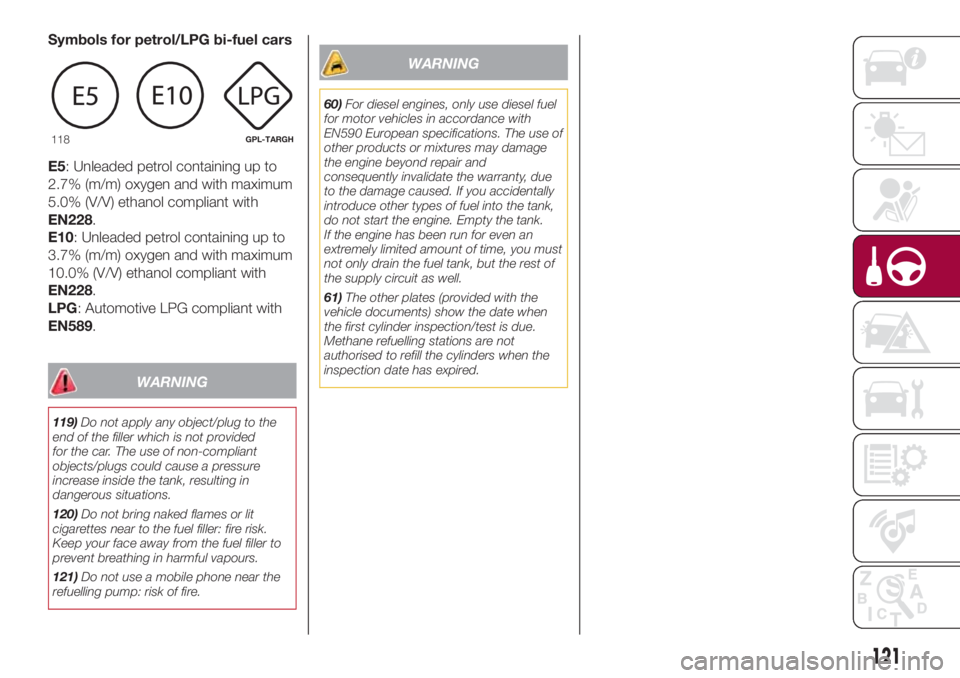
Symbols for petrol/LPG bi-fuel cars
E5: Unleaded petrol containing up to
2.7% (m/m) oxygen and with maximum
5.0% (V/V) ethanol compliant with
EN228.
E10: Unleaded petrol containing up to
3.7% (m/m) oxygen and with maximum
10.0% (V/V) ethanol compliant with
EN228.
LPG: Automotive LPG compliant with
EN589.
WARNING
119)Do not apply any object/plug to the
end of the filler which is not provided
for the car. The use of non-compliant
objects/plugs could cause a pressure
increase inside the tank, resulting in
dangerous situations.
120)Do not bring naked flames or lit
cigarettes near to the fuel filler: fire risk.
Keep your face away from the fuel filler to
prevent breathing in harmful vapours.
121)Do not use a mobile phone near the
refuelling pump: risk of fire.
WARNING
60)For diesel engines, only use diesel fuel
for motor vehicles in accordance with
EN590 European specifications. The use of
other products or mixtures may damage
the engine beyond repair and
consequently invalidate the warranty, due
to the damage caused. If you accidentally
introduce other types of fuel into the tank,
do not start the engine. Empty the tank.
If the engine has been run for even an
extremely limited amount of time, you must
not only drain the fuel tank, but the rest of
the supply circuit as well.
61)The other plates (provided with the
vehicle documents) show the date when
the first cylinder inspection/test is due.
Methane refuelling stations are not
authorised to refill the cylinders when the
inspection date has expired.
118GPL-TARGH
121
Page 129 of 268

If you are on a slope or uneven surface,
place the wedge provided under the wheel
(see the instructions on the next pages).
124)The vehicle's driving characteristics
will be modified with the space-saver wheel
fitted. Avoid violent acceleration and
braking, abrupt steering and fast cornering.
The overall duration of the space-saver
wheel is of about 3000 km, after which the
relevant tyre must be replaced with another
one of the same type. Never install a
standard tyre on a rim that is designed for
use with a space-saver wheel. Have the
wheel repaired and refitted as soon as
possible. Using two or more space-saver
wheels at the same time is forbidden.
Do not grease the threads of the stud bolts
before fitting them: they might slip out.
125)The jack is a tool developed and
designed only for changing a wheel, if a
tyre gets punctured or damaged, on the
vehicle with which it is supplied or on other
vehicles of the same model. Any other
use, e.g. to jack up other vehicle models or
different things, is strictly prohibited. Never
use it to carry out maintenance or repairs
under the vehicle or to change summer/
winter wheels and vice versa: we advise
you to contact a Fiat Dealership. Never go
under the raised vehicle: use it only in
the positions indicated. Do not use the jack
for loads higher than the one shown on
its label. Never start the engine with car
raised. If the vehicle is raised more than
necessary, everything can become more
unstable, with the risk of the vehicle
dropping violently. Thus, lift the car only as
needed in order to access the space-saver
spare wheel.126)The space-saver wheel cannot be
fitted with snow chains. If a front (drive) tyre
is punctured and chains are needed, use
a standard wheel from the rear axle and
install the space-saver wheel on the rear
axle. In this way, with two normal drive
wheels at the front axle, it is possible to use
snow chains.
127)When turning the jack handle make
sure that it can turn freely without scraping
your hand against the ground. The moving
components of the jack ("worm screw"
and joints) can also cause injuries: do not
touch them. If you come into contact
with lubricating grease, clean yourself
thoroughly.
128)If the hub cap is not fitted correctly, it
may come off when the car is travelling.
Never tamper with the inflation valve. Never
introduce tools of any kind between rim
and tyre. Check tyre and space-saver
wheel pressures regularly, complying with
the values given in the "Technical
specifications" chapter.
129)At the end of the operation of
raising/locking the space-saver wheel
device, the spanner must be extracted,
taking care NOT to turn it in the wrong
direction to facilitate the extraction of the
spanner itself, so as to prevent the
attachment device from being released and
the lack of safe restraint.
WARNING
62)Contact a Fiat Dealership as soon as
possible to have the correct tightening
of the wheel stud bolts checked.
“Fix&Go Automatic”
KIT
130) 131)
63)2)
DESCRIPTION
The Fix&Go Automatic kit is located in
the boot, inside a dedicated container.
The container is also equipped with
a screwdriver, the tow hook and the
funnel for refuelling in an emergency. To
access the kit, open the boot door,
remove the load platform and lift the
covering carpet.
LPG versions
The kit is located in a bag fixed to the
boot lining by means of Velcro.
The kit fig. 130 contains:
one cartridge A containing sealant
and fitted with: transparent tube for
injecting the sealant 4 and sticker
C with the wording MAX 80 km/h / 50
mph to be placed in a clearly visible
position (e.g. on the dashboard) after
repairing the tyre;
a compressor B;
one leaflet containing instructions for
using the kit;
127